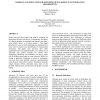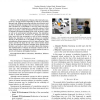50 search results - page 1 / 10 » Modeling and simulation for exploring human-robot team inter... |
FLAIRS
2003
13 years 8 months ago
2003
We have developed a model-based, distributed architecture that integrates diverse components in a system designed for lunar and planetary surface operations: an astronaut’s spac...
WSC
2001
13 years 8 months ago
2001
Small-sized and micro-robots will soon be available for deployment in large-scale forces. Consequently, the ability of a human operator to coordinate and interact with largescale ...
AAAI
2007
13 years 9 months ago
2007
How should a robot represent and reason about spatial information when it needs to collaborate effectively with a human? The form of spatial representation that is useful for robo...
ACHI
2010
IEEE
14 years 2 months ago
2010
IEEE
Abstract—The development of human-robot interaction scenarios is a strongly situation-dependent as well as an extremely dynamic task. Humans interacting with the robot directly r...
HRI
2006
ACM
14 years 1 months ago
2006
ACM
Autonomous robots use sensors to perceive and track objects in the world. Tracking algorithms use object motion models to estimate the position of a moving object. Tracking effic...


